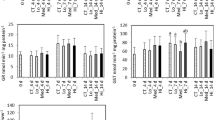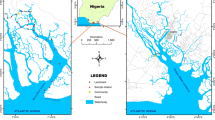Abstract
Coho salmon (Oncorhynchus kisutch) and starry flounder (Platichthys stellatus) were exposed to 0.9±0.1 ppm of a water-soluble fraction (WSF) of Prudhoe Bay crude oil in flowing sea water. Both species accumulated a complex spectrum of low molecular weight aromatic hydrocarbons. Bioconcentration factors (ppm hydrocarbon based on dry weight of tissue/ ppm hydrocarbon in flow-through water) for most hydrocarbons in starry flounder muscle were substantially higher than for coho salmon muscle. After two weeks of exposure, for example, there were 17 ppm (dry weight of tissue) of C4- and C5-substituted benzenes in muscle of starry flounder (bioconcentration factor of 1,700) but only 1.5 ppm of these compounds occurred in muscle of coho salmon (bioconcentration factor of 150). Generally, alkylated aromatic hydrocarbons accumulated in tissues to a greater degree than unsubstituted derivatives. In both species, accumulations of substituted benzenes and naphthalenes in muscle increased in relation to the degree of alkylation. Complex mixtures of aromatic hydrocarbons were found in gills and liver of starry flounder. Accumulated hydrocarbons in coho salmon exposed for six weeks fell below limits of detection within a week when fish were transferred to clean water. Starry flounder exposed for two weeks retained substantial concentrations (7 to 26 ppm) of C2-C3-substituted naphthalene and C4-C5-substituted benzenes in muscle two weeks after the termination of exposure. Substantial variations were found in bioconcentration factors for individual hydrocarbons in both species. Thus the data reflect difficulties in relating specific sources of petroleum pollution to hydrocarbon profiles in tissues.
Similar content being viewed by others
References
Anderson, J. W., J. M. Neff, B. A. Cox, H. E. Tatem, and G. M. Hightower: The effect of oil on estuarine animals: Toxicity, uptake and depuration, respiration, In F. J. Vernberg and W. B. Vernberg (eds.): Pollution and Physiology of Marine Organisms, pp. 285–310. New York: Academic Press (1974).
Anderson, J. W.: Laboratory studies on the effects of oil on marine organisms: An overview. Am. Petrol. Inst. Publ. No. 4249 (1975).
Gruger, E. H., Jr., M. M. Wekell, P. T. Numoto, and D. R. Craddock: Induction of hepatic aryl hydrocarbon hydroxylase in salmon exposed to petroleum dissolved in sea water and to petroleum and polychlorinated biphenyls, separate and together, in food. Bull. Environ. Contam. Toxicol.17, 512 (1977).
Hanson, S. W. F., and J. Olley: Application of the Bligh and Dyer method of lipid extraction of tissue homogenates. Biochem. J.89, 101P (1963).
Lee, R. F., D. Sauerheber, and G. H. Dobbs: Uptake, metabolism and discharge of polycyclic aromatic hydrocarbons by marine fish. Mar. Biol.17, 201 (1972).
MacLeod, W. D., D. W. Brown, R. G. Jenkins, L. S. Ramos, and V. D. Henry: A pilot study on the design of a petroleum hydrocarbon baseline investigation for Northern Puget Sound and Strait of Juan de Fuca.NOAA Tech. Memo. ERL MESA-8,Marine Ecosystems Analysis Program Office, Boulder, Colorado (Nov. 1976).
Malins, D. C.: Biotransformation of petroleum hydrocarbons in marine organisms indigenous to the arctic and subarctic. In D. Wolfe (ed.): Proceedings of Symposium on Fate and Effects of Petroleum Hydrocarbons in Marine Ecosystems and Organisms. New York: Pergamon Press (1977a).
Malins, D. C.: Metabolism of aromatic hydrocarbons in marine organisms. Ann. N.Y. Acad. Sci.298, 482 (1977b).
Meyerhoff, R. D.: Acute toxicology of benzene, a component of crude oil, to juvenile striped bass(Morone saxatilis). J. Fish. Res. Board Can.32, 1864 (1975).
Neff, J. M., D. Dixit, B. A. Cox, and J. W. Anderson: Accumulation and release of petroleum derived aromatic hydrocarbons by four species of marine animals. Mar. Biol.38, 279 (1976).
Roubal, W. T., T. K. Collier, and D. C. Malins: Accumulation and metabolism of carbon-14 labeled benzene, naphthalene and anthracene by young coho salmon(Oncorhynchus kisutch). Arch. Environ. Contam. Toxicol.5, 513 (1977a).
Roubal, W. T., D. H. Bovee, T. K. Collier, and S. I. Stranahan: Flow-through system for chronic exposure of aquatic organisms to sea water-soluble hydrocarbons from crude oil. In: Proceedings of 1977 Oil Spill Conference (Prevention, Behavior, Control, Cleanup), p. 551. American Petroleum Institute, Washington, D.C. (1977b).
Varanasi, U., and D. C. Malins: Metabolism of petroleum hydrocarbons: Accumulation and biotransformations in marine organisms. In D. C. Malins (ed.): Effects of Petroleum on Arctic and Subarctic Marine Environments and Organisms, Vol. II, p. 175. New York: Academic Press (1977).
Whittle, K. J., J. Murray, P. R. Mackie, R. Hardy, and J. Farmer: Fate of hydrocarbons in fish. Int. Counc. Explor. Sea (1974a).
Whittle, K. J., P. R. Mackie, and R. Hardy: Hydrocarbons in the marine ecosystem. S. Afr. J. Sci.70, 141 (1974b).
Author information
Authors and Affiliations
Rights and permissions
About this article
Cite this article
Roubal, W.T., Stranahan, S.I. & Malins, D.C. The accumulation of low molecular weight aromatic hydrocarbons of crude oil by coho salmon (Oncorhynchus kisutch) and starry flounder (Platichthys stellatus). Arch. Environ. Contam. Toxicol. 7, 237–244 (1978). https://doi.org/10.1007/BF02332052
Received:
Accepted:
Issue Date:
DOI: https://doi.org/10.1007/BF02332052




